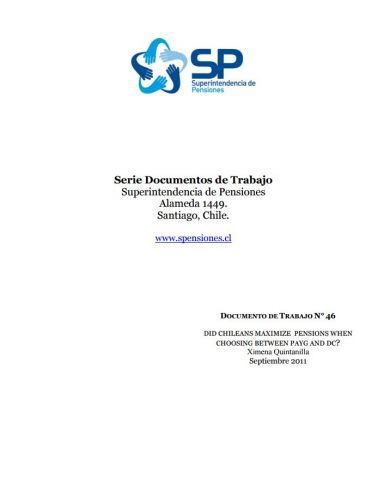
In 1981 Chile was the first country in the world to privitise its pension system moving from a traditional unfunded pay-as-you-go scheme (PAYG), where benefits are defined ex-ante by a final salary formula, to a Defined Contributions (DC) scheme where each individual's benefit depends entirely on his own pension savings. Individuals in the labour market at the time of the reform were given the choice to either stay in the old PAYG system or to opt-out to the DC scheme, whereas new entrants must join the DC system. Exploiting the wide differences in pension formulas across schemes, in this paper we analyse for whom it was financially optimal (in terms of higher net present value of expected pension wealth, EPW) to opt-out and for whom to stay in the PAYG system. Using self-reported employment and contribution histories, we compute the net present value of EPW each individual in our sample will get in the pension scheme he is currently enrolled to and the pension he would have got had he made the opposite staying/opting-out out decision. We find that overall 87% of individuals would have got a higher pension in the DC system than what they would have got in the PAYG scheme. This share varies significantly by cohort but not so much by education or sex. When looking at who actually maximised the net present value of EPW when choosing pension arrangement the results show that 57% did. Thus, when faced with the choice of pension system, only over half of individuals took the financially right decision. Responses vary across current pension system: while 90% of men and 80% of women currently in the PFA maximised the net present value of EPW, less than 15% of individuals currently in the PAYG did. En 1981 Chile fue el primer país del mundo en privatizar su sistema de pensiones pasar de un tradicional sin financiación pay-as-you-go esquema (de reparto), donde los beneficios se definen a priori por una fórmula sueldo final, a una Definidos Aportaciones ( DC) esquema donde el beneficio de cada individuo depende totalmente de sus propios ahorros de pensiones. Los individuos en el mercado de trabajo en el momento de la reforma se les dio la opción de o bien permanecer en el sistema de reparto de edad o de optar por el esquema de CC, mientras que los nuevos operadores deben incorporarse al sistema de CC. La explotación de las grandes diferencias en las fórmulas de pensiones a través de esquemas, en este trabajo se analizan para quien era económicamente óptima (en términos de mayor valor actual neto de la riqueza de pensiones era de esperar, EPW) de optar por y para quienes permanecer en el sistema de reparto. Uso de empleo y contribución historias auto-reporte, calculamos el valor presente neto de EPW cada individuo en nuestra muestra se pondrá en el plan de pensiones que está inscrito actualmente y la pensión que hubiera obtenido si hubiera hecho la permanencia frente / opting-out decisión a cabo. Nos parece que, en general el 87% de las personas hubiera obtenido una pensión más alta en el sistema DC de lo que habrían conseguido en el régimen de reparto. Esta proporción varía significativamente por cohorte, pero no tanto por la educación o el sexo. Cuando observamos que realmente maximiza el valor presente neto de EPW al elegir plan de pensiones, los resultados muestran que el 57% lo hizo. Por lo tanto, cuando se enfrentan a la elección del sistema de pensiones, sólo sobre la mitad de las personas tomó la decisión financieramente derecha. Las respuestas varían a través del sistema de pensiones actual: mientras que el 90% de los hombres y el 80% de las mujeres actualmente en el PFA maximizan el valor presente neto de EPW, menos del 15% de las personas actualmente en el reparto hizo.